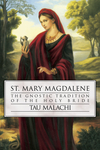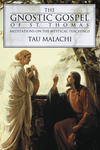Hail Mary

In Dan Brown’s best-selling novel, The Da Vinci Code, he theorized that there were small secret societies that maintained teachings and practices of a very different form of Christianity, one that was deeply spiritual and mystical, and that honored the Sacred Feminine. Although in some forms of Christianity, to an extent, the Virgin Mary personifies the Sacred Feminine, he proposed that in this more esoteric form of Christianity, St. Mary Magdalene was the central figure representing the Sacred Feminine in the Gospel. Though writing a fictional work, perhaps based more in suspicions and intuitions than fact in his portrayal of teachings, rites and rituals, nevertheless Mr. Brown is correct—there are living traditions that have survived as “secret societies” which honor St. Mary Magdalene as a personification of the Sacred Feminine and as a central figure in the Gospel.
The Sophian Tradition of Gnostic Christianity has existed for several hundred years, and given the discovery of ancient and sacred Gnostic texts in which Sophia and Mary Magdalene play essential roles, we know Sophian forms of Christianity existed from very early times in the Christian movement. An excellent example is a Gnostic Gospel that has come to be called Pistis Sophia (Faith-Wisdom), which tells a story of the fall and redemption of the Bride, Sophia, and in which Mary Magdalene is portrayed as the most illumined and closest of all the disciples of Jesus. Interestingly enough, prior to the translation and publication of the Pistis Sophia by G. R. S. Mead, legends of the fall and redemption of Sophia were told in an oral tradition of Sophian Gnosticism that cast St. Mary Magdalene in the role of the Holy Bride, Sophia.
In this oral tradition that has passed from one generation of initiates to another, St. Mary Magdalene is said to be the wife, consort and inmost disciple of Jesus. However, something more is said of her, for it is taught that she also experienced the Divine Illumination of the Christ in a woman’s form, Christ the Sophia, and that she was the co-preacher of the Gospel with Jesus. In other words, according to this Gnostic Tradition, Mary Magdalene was far more than merely the wife and disciple of Jesus, for she embodied the same self-realization of Christ
consciousness.
There are literally hundreds of stories about St. Mary Magdalene told in the Sophian lineage of Gnostic Christianity, and there are hundreds of spiritual teachings and sayings attributed to her. In fact, there are two lines of legend concerning her in the Sophian Tradition: one that speaks of her as Mary of Bethany, called the Magdalene, and another which speaks of her as Mary of Magdal. In the book, St. Mary Magdalene: The Gnostic Tradition of the Holy Bride, I draw from the legends that speak of her as Mary of Magdal and that are founded upon ancient Gnostic teachings of the fall and redemption of the Holy Bride, Sophia. This book represents the first time these stories and sayings have been recorded in writing and openly shared in a public forum.
In Gnostic Christianity, more than we believe in the person of Jesus, we believe in the Christ and the teachings of Christ, and the same is true of St. Mary Magdalene. It is not so much that we believe in the person of Mary, but rather we believe in the Holy Bride, Sophia, and the teachings of Sophia—the Wisdom of Christ. In Gnostic tales, the purpose is not to communicate literal or historical facts, but rather to convey spiritual and metaphysical truths, and to create vehicles in the mind and heart through which we might enter into direct spiritual and mystical experience—it is all about the Gnostic experience of the Truth and Light.
This, in essence, is the purpose of St. Mary Magdalene: The Gnostic Tradition of the Holy Bride—to help readers come in touch with the presence and power of the Holy Bride and, perchance, to enter into a direct spiritual or mystical experience of her in their own lives. In this sense, these stories and sayings from the oral Sophian Tradition are magical, for they invoke the Holy Bride in our minds and hearts, and they connect us to the spiritual energy of the Living Sophia.
This was certainly my experience in writing St. Mary Magdalene, for when I sat down to begin the book I thought it would be a project spanning several months, and as it turned out, the book was written in several weeks. I swiftly found my thoughts and dreams filled with the tales of the Holy Bride, which flowed out into written words from the first thing in the morning until late into the evening—it was a most intimate and magical journey with the Living Sophia, and, at times, a rapturous union of pure joy.
It is my hope that readers of the book might also experience sweetness of communion with Our Lady in Red, the Anointed Bride.

About Tau Malachi
Related Products


is subject to certain Terms and Conditions